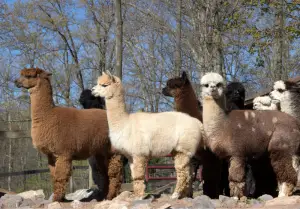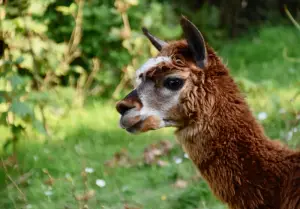Aggressive Alpaca Behavior & Body Language
Alpacas communicate not only with body language but also through a series of vocalizations. While possibly the most common belief about alpaca body language is that they will spit at anything that annoys them, this is not strictly accurate. Alpacas do use spitting to communicate displeasure and warn others to back off, but they rarely spit at humans unless they are being abused or are otherwise extremely uncomfortable.
Are alpacas dangerous? While alpacas might at times demonstrate aggressive behavior, well trained alpacas raised in the correct environment don’t pose much risk to humans. The most important thing to know about alpaca body language is that an alpaca invading your personal space and nibbling at your clothes is not cute and should be pointedly discouraged. Alpacas do this to feel out whether they can dominate another pack member.
If you let an alpaca bump into you and you tolerate other rude behaviors, it will take that as submission from you and strive to rise above you in the herd hierarchy. This is a situation best avoided. Read on for ways to prevent this from happening.
Aggressive Alpaca Body Language 
A submissive alpaca minding her own business and not looking to start anything will approach a human or another herd member with the tail held upright and the neck lowered. This is a posture expressing that no domination attempts will be made. If an alpaca approaches you in this fashion, all is well.
Problems arise when an alpaca approaches with its neck stretched out and head held high as if trying to look as big as possible. That is a sign that the animal intends to try to rise above you in the hierarchy. Other signs precluding this negative behavior include sniffing at the crotch area or the feet, yanking on shoelaces, laying down and rolling over shoes as if trying to knock the person over, and blatantly running into the person. These are all aggressive behaviors that can become dangerous.
Alpaca Behavior With Berserk Male Syndrome
The worst display of dominance in alpacas happens when a male charges another individual, whether an alpaca or a human, and launches into them with all four feet off the ground. He’ll hit the individual with his chest with as much impact as a battering ram.
This and other dominance behaviors can be bad manners in general, or in severe cases, can indicate a real problem with males called “Berserk Male Syndrome.” Berserk Male Syndrome is a social issue that develops in male llamas and alpacas who have been coddled too much by humans and have not learned the normal social behaviors of the herd. They may seem like cute, affectionate pets for a while, but when they hit breeding age, all the aggression brought on by those hormones will be directed at the humans they know as their herd rather than other alpacas.
These behaviors should all be strongly discouraged. The best way to prevent these behaviors is to discourage them from the very beginning. This is most commonly seen in bottle-fed males who grew up around people more than other alpacas. If it is at all possible for you to avoid causing this situation, do so. Let them grow up with their own kind and learn the social rules from their fellow alpacas.
Don’t misjudge an alpaca sizing you up to mean the alpaca likes you and wants to be affectionate and get pets. Shouting “No!” at the animal may be all it takes if the issue is addressed early enough. Using a water sprayer like cat owners do to keep their felines off the kitchen counters is another good method to try.
For alpacas that are already charging and trying to knock you over, you may try pulling your knee up to your chest so that they hit that and feel more discomfort with it than they would just hitting your chest. A slap may surprise an aggressor into reevaluating his decision to mess with you. Males who persist may be calmed down by gelding. In the most severe cases of Berserk Male Syndrome, offending males must be euthanized for the safety and wellbeing of the humans on the property.
Ways Alpacas Express Negative Emotions
Sometimes alpacas act in a negative way because they feel scared of an approaching human or tense and unsure because of a new environment or herd member. In some cases, you might not know what caused usually relaxed alpacas to behave grouchily.
But as long as you are familiar with what their body language and vocalizations mean, you’ll be able to respond appropriately and prevent further discomfort to the animals or accidental injury to yourself.
Spitting
While alpacas do not spit nearly as often as people commonly think, it’s still an experience best avoided. Spitting is always a negative behavior in alpacas. It is always used to communicate discomfort in a situation or downright irritation.
Alpacas have two kinds of spit. The first is a warning and is simply a small amount of saliva and air. The real one is green and full of stuff they’ve been eating. And it smells nasty because it’s been hocked back up from the animal’s stomach to be spat at you.
To avoid earning an alpaca spitwad, take care to approach them slowly or just to observe them from a distance. Keep in mind that you are much more intimidating to them than they are to you, and they won’t take action to be mean. Just to protect themselves from a potential life-threatening situation.
Showing the Teeth 
Sometimes the movement of the nose to sniff the air pulls up the alpacas’ lips in a way that shows their teeth. This can just be a display of curiosity. The alpaca is sniffing and tasting the air to figure out what you are and what food offerings you may have with you.
Unfortunately, it is possible for this to be a sign of poor health in an alpaca. It is not natural for an alpaca’s teeth to show all of the time. If that is the case with one of your animals, it could be that their teeth need some attention.
Alpacas have teeth that constantly grow throughout their lives, like rabbits, and while they should rub against each other in such a way as to maintain the correct shape and length, it is possible for teeth to grow out of whack after some time. Teeth can be groomed back into the shape they should be, but this requires expertise and should not be attempted by a novice. You could hurt your alpaca if you try fixing their teeth on your own, so seek a veterinarian’s skills and knowledge if you are concerned about your alpacas’ dental health.
Raising the Tail
This one is a little complicated and not necessarily a negative or positive behavior. A tail held erect could mean a variety of things from submission to a challenge for dominance.
- Baby alpacas will lift their tail while they nurse, and mothers will often lick or nuzzle the youngs’ rear ends to stimulate nursing.
- Young alpacas approaching older members of the herd use tail raising as a sign of submission and to show that they aren’t there to challenge anyone.
- Adult males will raise their tails to attract females or try to look bigger to other males
Ways Alpacas Express Positive Emotions
Ears Back
With most other animals, holding the ears back behind the face is usually a sign of annoyance or a warning before a bite or other clearer communication to back off. But alpacas actually hold their ears back sometimes when relaxed.
Alpacas are prey animals with almost no self-defense mechanisms other than running for cover, so their ears will hover one direction or the other frequently in order to keep tabs on their surroundings so nothing dangerous can sneak up on them.
Warning Whistle
Alpacas are capable of emitting a high-pitch warning call to alert others to impending danger. In a farm setting, this will alert the humans, guard dogs, and other animals that a problem is approaching and everyone should be on alert. It can be startling, but also beneficial if there really is danger near.
Clicking
Mothers will hum and click to their young, especially during their first couple of weeks, so that their babies can learn their voices to find them in a crowded farmyard full of others.
Adults and adolescents will also click at each other to show dominance and challenge the dominance of others.
Humming
Alpacas sometimes hum when they are going about their daily lives feeling contented and not stressed. But they may hum even louder if something happens to annoy them. Males also hum to females they are courting.
Chilling
Alpacas also just enjoy hanging out in the field with their herd. As long as nothing disturbs the peace, they’ll graze and meander all day. That is normal behavior for them and a sign that they are content with their lives and that you have done well providing them with everything they need.
How Do Alpacas Show Affection?
Keep in mind that rubbing against you, biting at your clothes and shows, and rolling around on your feet are NOT affectionate behaviors, but rather precursors to more dangerous aggressive behaviors. Do not allow these behaviors to continue.
Instead, offer your alpaca a treat. Once he trusts you, he will enjoy taking snacks from your hand. Approaching you calmly to inquire about treats is another way an alpaca shows that it is curious about you and maybe even glad to see you without feeling any aggression toward you.

